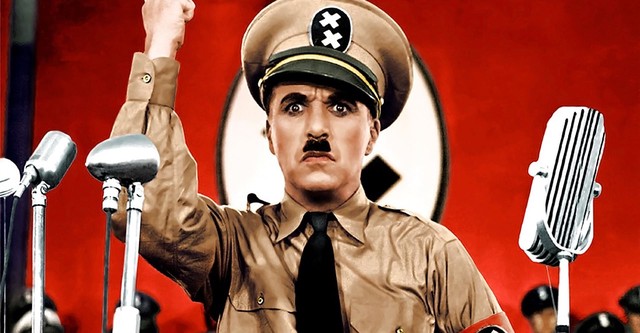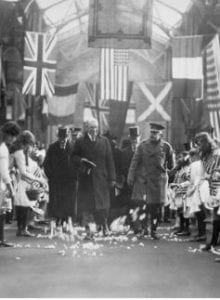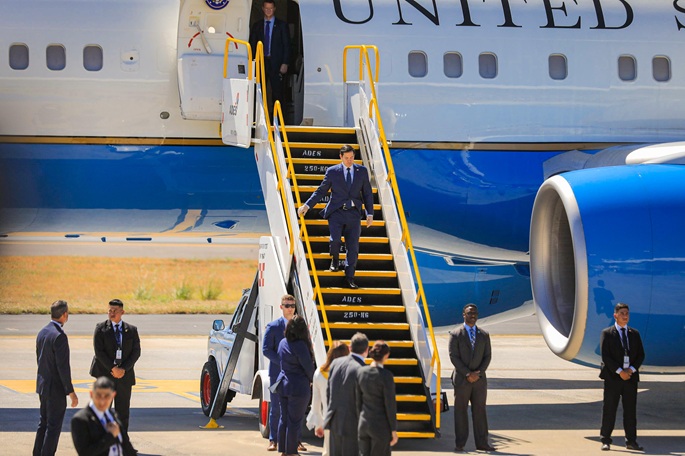 BORDERLANDS
BORDERLANDS
V.25 I. 03.05.25
Introduction
Contrary to current opinion, the ongoing conflict is not one-sided, nor is it two-sided, recent events have illustrated it. From the dressing down of the emperor with no clothes in the Oval Office recently by its principal supporter and supplier of arms and money, to that very support and supply being summarily revoked, to the European alliance known as NATO discovering it must act alone as a unified command, to rallies worldwide offering informal support, the war is multi-faceted.
All of this can be examined from a perspective of language, in particular the rhetoric of demagoguery, which is playing an increasing part in where the battle is headed, both on the front lines and away from it.
(Image credit: The Great Dictator streaming: where to watch online?)
Methodology
Synthetic intelligence (AI) queries are placed into the Capsules section, marked by (Perplexity-AI) and (End Perplexity-AI), followed by Notes and an Afterword. Normally, other sections are included such as Congressional Record and Media; that works well in evidence gathering, less in theoretical works as seen here.
Capsules
Social media posts omitted.
(Begin Perplexity-AI)
types of demagoguery
Demagoguery can take various forms, often involving rhetorical strategies aimed at manipulating emotions, bypassing reasoned deliberation, and gaining power or influence. Below are some classifications and tactics of demagoguery:
Types of Demagoguery Based on Logical Integrity
-
Demagogues Without Violation of Logic:
-
Use selective omission of facts to mislead audiences while maintaining logical consistency. For example, omitting critical details that change the conclusion1.
-
-
Demagoguery with Imperceptible Violation of Logic:
-
Employ subtle logical fallacies, such as assuming causation from correlation or creating false dichotomies (e.g., “If you don’t agree with me, you support my opponent”)1.
-
-
Demagoguery Without Regard to Logic:
-
Use rhetorical distractions and emotional appeals without addressing the core argument. Examples include answering a different question than posed or referencing non-expert authorities to validate claims1.
-
Tactics Commonly Used by Demagogues
-
Scapegoating:
-
Blaming societal problems on an out-group (e.g., ethnic or religious minorities) to unify the in-group against a common enemy2.
-
-
Fearmongering:
-
Stirring fear to provoke action and prevent rational debate (e.g., exaggerating threats like terrorism or crime)2.
-
-
Lying:
-
Spreading falsehoods for emotional impact, often escalating lies when challenged2.
-
-
Accusing Opponents of Weakness or Disloyalty:
-
Portraying opponents as traitorous or weak to delegitimize them and appeal to nationalist or authoritarian sentiments2.
-
-
Promising the Impossible:
-
Making grandiose promises without any realistic plan for fulfillment2.
-
-
Gross Oversimplification:
-
Reducing complex issues to overly simplistic solutions, such as attributing all problems to a single cause2.
-
-
Attacking the Media:
-
Discrediting the press to undermine factual reporting that could challenge their narrative2.
-
These forms and tactics of demagoguery are often used in combination to manipulate public opinion and consolidate power.
https://www.perplexity.ai/search/types-of-demagoguery-fC5eLu6aR7qxdmQZ3oUu6A
demagogue rhetoric is not necessarily disinformation
Demagogue rhetoric is not necessarily synonymous with disinformation, though the two can overlap. Demagoguery is characterized by appeals to emotion, identity, and division rather than reasoned deliberation. It often involves tactics like scapegoating, fearmongering, oversimplification, and attacks on institutions like the media13. While these techniques may involve falsehoods, they do not require them to be effective. For instance, a demagogue may use truthful but inflammatory rhetoric to exploit societal divisions or amplify distrust in institutions4.
Disinformation, on the other hand, specifically refers to the deliberate spread of false information to mislead or manipulate. While demagogues often disregard truth in favor of emotional impact, their rhetoric can also include truthful statements framed in ways that incite passion or division14. Furthermore, some scholars argue that demagoguery can serve legitimate purposes in certain contexts, such as advocating for marginalized groups or addressing crises of legitimacy14.
Thus, while demagogic rhetoric frequently employs lies or distortions, it is not inherently tied to disinformation. Instead, its defining feature is its intent to bypass reasoned debate in favor of emotional manipulation.
https://www.perplexity.ai/search/demagogue-rhetoric-is-not-nece-IC4PBgDJSrCbYWSqgL1pbA
examples of demagogue rhetoric in the ukraine-russia conflict
The Ukraine-Russia conflict has been marked by significant use of demagogue rhetoric, particularly from Russian President Vladimir Putin and other Russian officials. Here are some examples of demagogic rhetoric used in this conflict:
Putin’s Narratives
-
Western Blame: Putin consistently portrays the West, particularly the US and NATO, as aggressors threatening Russia’s security. He claims that the West is responsible for the tensions in the region, including the 2014 Maidan revolution in Ukraine12.
-
Historical Distortion: Putin misuses historical facts to strengthen his arguments. For instance, he falsely claims that in 2008, the US convinced NATO allies to open the door for Ukraine and Georgia’s membership, when in reality, this did not happen1.
-
Russia as Defender: Putin frames Russia’s actions as defensive, claiming that Russia was “forced to go ahead with the special military operation” due to mounting risks and threats1.
-
Ukraine as “Anti-Russia:” Putin accuses the West of creating an “anti-Russia” in Ukraine, claiming they have been preparing Ukraine for a clash with Russia on both military and social levels1.
Dehumanization and Cruel Speech
-
Nazi Comparisons: Russian officials frequently compare Ukrainians to German Nazis, using this historical parallel to justify aggression13.
-
Genocidal Language: Putin and other Russian officials use terms like “genocide” and “torture” to provoke emotional responses and justify their actions13.
-
Dehumanizing Metaphors: Russian media figures use dehumanizing metaphors, such as comparing the invasion to “worming a cat”3.
Propaganda and Disinformation:
-
State Media Discourse: Russian state media constructs elaborate narratives about Ukraine, centered on historical and geopolitical fables, conveyed through repetitive tropes and tones of speech3.
-
Scapegoating: Putin presents the West as a scapegoat for Russia’s problems, blaming them for the collapse of the Soviet Union and current political turmoil2.
-
False Narratives: Russian communications systems design webs of narratives aimed at destroying communal trust and security in Ukraine3.
This demagogic rhetoric serves to justify Russia’s actions, demonize opponents, and rally support among the Russian population. It demonstrates the dangerous potential of such language in escalating conflicts and shaping public perception5
https://www.perplexity.ai/search/examples-of-demagogue-rhetoric-8Lmw8MSNRTuEV8ETjqkrZQ
demagogue rhetoric means not siding with ukraine is siding with russia
The statement “not siding with Ukraine is siding with Russia” is an example of demagogic rhetoric, which oversimplifies a complex situation and creates a false dichotomy. Demagogues often use such tactics to manipulate public opinion and emotions.
Demagogic rhetoric typically involves:
-
Oversimplification of complex issues
-
Appeal to emotions rather than reason
-
Scapegoating and creating “us vs. them” narratives
-
Use of fear and threats to mobilize support
In the context of the Russia-Ukraine conflict, this type of rhetoric can be observed on multiple sides:
-
Russian propaganda: Putin’s government has used demagogic tactics to justify its actions, portraying Ukraine as a threat and denying its sovereignty13. This includes false claims about genocide in Donbas and portraying Russia as a victim defending itself against Western aggression3.
-
Western rhetoric: Some Western leaders and media outlets have used similar tactics, presenting the conflict as a clear-cut battle between good and evil, potentially oversimplifying the situation2.
-
Ukrainian perspective: While Ukraine is defending itself against Russian aggression, some Ukrainian officials have also employed strong rhetoric, criticizing perceived lack of support from other nations6.
It’s important to recognize that international relations and conflicts are often complex, with multiple factors and perspectives involved. Reducing such situations to simplistic “with us or against us” narratives is a hallmark of demagogic rhetoric, which can be dangerous and counterproductive to finding peaceful resolutions5.
Ultimately, while it’s crucial to condemn Russia’s illegal invasion and support Ukraine’s sovereignty, it’s equally important to maintain nuanced, fact-based discussions about the conflict and its potential resolutions, rather than resorting to overly simplistic or emotionally charged rhetoric.
https://www.perplexity.ai/search/demagogue-rhetoric-means-not-s-Wa5OiL20TpCRNWnkcpmLjg
zelensky saying trump is disinformed is demagoguery language
Ukrainian President Volodymyr Zelensky’s recent remarks about former U.S. President Donald Trump being “surrounded by disinformation” or living in a “Russian disinformation space” have sparked significant debate. Zelensky made these comments in response to Trump’s claims that Ukraine started the war with Russia and that Zelensky’s approval rating is as low as 4%, which Zelensky called Russian propaganda128.
Zelensky accused Trump of being influenced by narratives crafted by Russia, particularly those that undermine Ukraine’s position in the ongoing conflict. He emphasized that such misinformation distorts the reality of the war and Ukraine’s efforts to resist Russian aggression, while also highlighting his actual approval rating, which he stated is much higher than Trump’s claim28. These remarks were part of a broader critique of U.S.-Russia discussions, which excluded Ukraine and appeared to favor Moscow’s positions2.
Critics might view Zelensky’s language as confrontational or demagogic, given its strong rhetoric against a former U.S. president. However, Zelensky’s statements align with his broader strategy of countering Russian narratives and defending Ukraine’s sovereignty on the global stage. This approach has also exposed tensions in U.S.-Ukraine relations, particularly under Trump’s leadership, as Trump has often expressed skepticism toward Ukraine and admiration for Russia34.
https://www.perplexity.ai/search/zelensky-saying-trump-is-disin-8N3Qko6fQqC4Rmz303gJ9A
protests supporting the war in ukraine do not help the peace process
Protests supporting the war in Ukraine can indeed complicate the peace process, but the situation is more nuanced than a simple statement suggests.
Protests in support of Ukraine’s defense against Russian aggression serve multiple purposes:
-
They demonstrate public solidarity with Ukraine’s right to self-defense against an unprovoked invasion2.
-
They pressure governments to maintain support for Ukraine, which can be seen as necessary to achieve a just peace2.
-
They counter Russian propaganda and attempts to normalize the invasion2.
However, these protests can also have unintended consequences:
-
They may harden positions on both sides, making compromise more difficult3.
-
They could potentially escalate tensions and prolong the conflict3.
-
They might overshadow voices calling for diplomatic solutions2.
It’s important to note that protests within Russia against the war have faced severe repression, with over 20,000 individuals subjected to reprisals for their anti-war positions5. This internal dissent in Russia could potentially contribute to ending the conflict.
The path to peace is complex and involves multiple factors:
-
Ukraine’s resilience and public opinion play a crucial role in shaping the government’s approach to potential negotiations3.
-
There’s a delicate balance between maintaining military pressure and pursuing diplomatic channels23.
-
International involvement, including from the U.S. and Europe, significantly influences the prospects for peace talks4.
Ultimately, while protests supporting Ukraine’s defense may complicate immediate peace efforts, they also reflect the complexity of the situation and the need for a just resolution that respects Ukraine’s sovereignty and territorial integrity23
https://www.perplexity.ai/search/protests-supporting-the-war-in-zUwqJd6gQpWX2Zp_BbqAow
(End Perplexity-AI)
Notes
Some of the more salient points of the query narrative above is where the actual concept of “disinformed” stands. The conclusion as to whether the US president chooses to accept the disinformation in order to enforce his narrative and let the audience decide would have been a much better position. The statement in its form made the president appear ignorant, which would follow a demagogue’s recipe all the way from forcing the neutral party to take sides to scapegoating, making the president look like the “out-group,” even after a landslide to victory. For that matter, it was an effort to attack the media, also caught in the middle, in order to get it to side with the charge of disinformation.
Afterword
The recent exchange of insults such as “dictator” and “disinformed” might make for great television, but it gets no one to the peace table. The president was in a position to call out the lack of elections and martial law in Ukraine, he was not disinformed on that. They were rather innocuous charges that could have been cleared up by a better understanding of the constitution of the embattled nation. In fact, the defensive posture taken reflected the attitude of a dictator, with the negative response and drawing attention back to Russia and its campaign of disinformation, which was already a matter of record.
The charge of being labelled a dictator could have been brushed off, it was a simple matter of a lesson in the Ukraine constitution, not a lesson in the demagoguery of Russia. The cost was immense, but now in the short run, the so-called “Allies,” given a free ride by the previous US administration, will now have to fend for themselves. In the long run, as history reveals, they were not able to do it in World Wars One and Two.

 #Ukraine
#Ukraine

